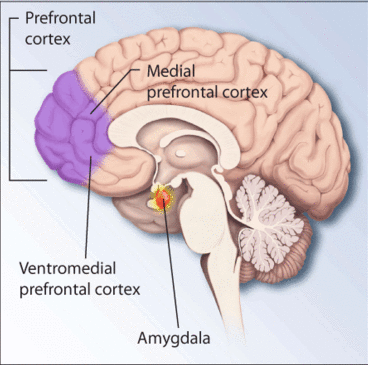|
Immersion Therapy
Immersion therapy is a psychological technique which allows a patient to overcome fears (phobias), but can be used for anxiety and panic disorders. Details First a fear-hierarchy is created: the patient is asked a series of questions to determine the level of discomfort the fear causes in various conditions. Can the patient talk about the object of their fear, can the patient tolerate a picture of it or watch a movie which has the object of their fear, can they be in the same room with the object of their fear, and/or can they be in physical contact with it? Once these questions have been ordered beginning with least discomfort to most discomfort, the patient is taught a relaxation exercise. Such an exercise might be tensing all the muscles in the patient's body then relaxing them and saying "relax", and then repeating this process until the patient is calm. Next, the patient is exposed to the object of their fear in a condition with which they are most comfortable - such as me ... [...More Info...] [...Related Items...] OR: [Wikipedia] [Google] [Baidu] |
Psychological
Psychology is the scientific study of mind and behavior. Its subject matter includes the behavior of humans and nonhumans, both consciousness, conscious and Unconscious mind, unconscious phenomena, and mental processes such as thoughts, feelings, and motivation, motives. Psychology is an academic discipline of immense scope, crossing the boundaries between the Natural science, natural and social sciences. Biological psychologists seek an understanding of the Emergence, emergent properties of brains, linking the discipline to neuroscience. As social scientists, psychologists aim to understand the behavior of individuals and groups.Hockenbury & Hockenbury. Psychology. Worth Publishers, 2010. A professional practitioner or researcher involved in the discipline is called a psychologist. Some psychologists can also be classified as Behavioural sciences, behavioral or Cognitive science, cognitive scientists. Some psychologists attempt to understand the role of mental functions in i ... [...More Info...] [...Related Items...] OR: [Wikipedia] [Google] [Baidu] |
Phobia
A phobia is an anxiety disorder, defined by an irrational, unrealistic, persistent and excessive fear of an object or situation. Phobias typically result in a rapid onset of fear and are usually present for more than six months. Those affected go to great lengths to avoid the situation or object, to a degree greater than the actual danger posed. If the object or situation cannot be avoided, they experience significant Distress (medicine), distress. Other symptoms can include fainting, which may occur in Blood phobia, blood or injury phobia, and panic attacks, often found in agoraphobia and emetophobia. Around 75% of those with phobias have multiple phobias. Phobias can be divided into specific phobias, social anxiety disorder, and agoraphobia. Specific phobias are further divided to include certain animals, natural environment, blood or injury, and particular situations. The most common are fear of spiders, fear of snakes, and fear of heights. Specific phobias may be caused by ... [...More Info...] [...Related Items...] OR: [Wikipedia] [Google] [Baidu] |
Relaxation Exercise
A relaxation technique (also known as relaxation training) is any method, process, procedure, or activity that helps a person to relax; attain a state of increased calmness; or otherwise reduce levels of pain, anxiety, stress or anger. Relaxation techniques are often employed as one element of a wider stress management program and can decrease muscle tension, lower blood pressure, and slow heart and breath rates, among other health benefits. Relaxation therapy, the application of relaxation techniques, can be applied in various settings to complement treatment for stress, anxiety, depression, and pain. It addresses both psychological and physiological effects of stress such as increased heart rate, sweating, and muscle tension. There are many variations of relaxation techniques, including progressive muscle relaxation, autogenic training, guided imagery, biofeedback-assisted relaxation, and other techniques. Thus, relaxation techniques are useful for either emotional pain cause ... [...More Info...] [...Related Items...] OR: [Wikipedia] [Google] [Baidu] |
Anxiety
Anxiety is an emotion characterised by an unpleasant state of inner wikt:turmoil, turmoil and includes feelings of dread over Anticipation, anticipated events. Anxiety is different from fear in that fear is defined as the emotional response to a present threat, whereas anxiety is the anticipation of a future one. It is often accompanied by nervous behavior such as pacing back and forth, Somatic anxiety, somatic complaints, and Rumination (psychology), rumination. Anxiety is a feeling of uneasiness and worry, usually generalized and unfocused as an overreaction to a situation that is only subjectively seen as menacing. It is often accompanied by muscular tension, restlessness, Fatigue (medical), fatigue, inability to catch one's breath, tightness in the abdominal region, nausea, and problems in concentration. Anxiety is closely related to fear, which is a response to a real or perceived immediate threat (fight-or-flight response); anxiety involves the expectation of a future t ... [...More Info...] [...Related Items...] OR: [Wikipedia] [Google] [Baidu] |
Phobias
The English language, English suffixes -phobia, -phobic, -phobe (from Ancient Greek, Greek φόβος ''phobos'', "fear") occur in technical usage in psychiatry to construct words that describe irrational, abnormal, unwarranted, persistent, or disabling fear as a mental disorder (e.g., agoraphobia), in chemistry to describe chemical aversions (e.g., hydrophobic), in biology to describe organisms that dislike certain conditions (e.g., acidophobia), and in medicine to describe hypersensitivity to a stimulus, usually sensory (e.g., photophobia). In common usage, they also form words that describe dislike or hatred of a particular thing or subject (e.g., homophobia). The suffix is antonymic to -phil-. For more information on the psychiatric side, including how psychiatry groups phobias such as agoraphobia, social phobia, or simple phobia, see phobia. The following lists include words ending in ''-phobia'', and include fears that have acquired names. In some cases, the naming of ph ... [...More Info...] [...Related Items...] OR: [Wikipedia] [Google] [Baidu] |
Acrophobia
Acrophobia, also known as hypsophobia, is an extreme or irrational fear or phobia of heights, especially when one is not particularly high up. It belongs to a category of specific phobias, called space and motion discomfort, that share similar causes and options for treatment. Most people experience a degree of natural fear when exposed to heights, known as the fear of falling. On the other hand, those who have little fear of such exposure are said to have a head for heights. A head for heights is advantageous for hiking or climbing in mountainous terrain and also in certain jobs such as steeplejacks or wind turbine mechanics. People with acrophobia can experience a panic attack in high places and become too agitated to get themselves down safely. Approximately 2–5% of the general population has acrophobia, with twice as many women affected as men. The term is from the , , meaning "peak, summit, edge" and , , "fear". The term "hypsophobia" derives from the Greek word (hypso ... [...More Info...] [...Related Items...] OR: [Wikipedia] [Google] [Baidu] |
Exposure Therapy
Exposure therapy is a technique in behavior therapy to treat anxiety disorders. Exposure therapy involves exposing the patient to the anxiety source or its context (without the intention to cause any danger). Doing so is thought to help them overcome their anxiety or distress. Numerous studies have demonstrated its effectiveness in the treatment of disorders such as generalized anxiety disorder (GAD), social anxiety disorder (SAD), obsessive-compulsive disorder (OCD), post-traumatic stress disorder (PTSD), and specific phobias. As of 2024, focus is particularly on exposure and response prevention (ERP or ExRP) therapy, in which exposure is continued and the resolution to refrain from the escape response is maintained at all times (not just during specific therapy sessions). Techniques Exposure therapy is based on the principle of respondent conditioning often termed Pavlovian extinction. The exposure therapist identifies the cognitions, emotions and physiological arousal that ... [...More Info...] [...Related Items...] OR: [Wikipedia] [Google] [Baidu] |
Flooding (psychology)
Flooding, sometimes referred to as in vivo exposure therapy, is a form of behavior therapy and desensitization – or exposure therapy – based on the principles of respondent conditioning. As a psychotherapeutic technique, it is used to treat phobia and anxiety disorders including post-traumatic stress disorder. It works by exposing the patient to their painful memories, with the goal of reintegrating their repressed emotions with their current awareness. Flooding was invented by psychologist Thomas Stampfl in 1967. It is still used in behavior therapy today. Flooding is a psychotherapeutic method for overcoming phobias. In order to demonstrate the irrationality of the fear, a psychologist would put a person in a situation where they would face their phobia. Under controlled conditions and using psychologically-proven relaxation techniques, the subject attempts to replace their fear with relaxation. The experience can often be traumatic for a person, but may be necessary ... [...More Info...] [...Related Items...] OR: [Wikipedia] [Google] [Baidu] |
Exposure Therapy
Exposure therapy is a technique in behavior therapy to treat anxiety disorders. Exposure therapy involves exposing the patient to the anxiety source or its context (without the intention to cause any danger). Doing so is thought to help them overcome their anxiety or distress. Numerous studies have demonstrated its effectiveness in the treatment of disorders such as generalized anxiety disorder (GAD), social anxiety disorder (SAD), obsessive-compulsive disorder (OCD), post-traumatic stress disorder (PTSD), and specific phobias. As of 2024, focus is particularly on exposure and response prevention (ERP or ExRP) therapy, in which exposure is continued and the resolution to refrain from the escape response is maintained at all times (not just during specific therapy sessions). Techniques Exposure therapy is based on the principle of respondent conditioning often termed Pavlovian extinction. The exposure therapist identifies the cognitions, emotions and physiological arousal that ... [...More Info...] [...Related Items...] OR: [Wikipedia] [Google] [Baidu] |
Behavior Therapy
Behaviour therapy or behavioural psychotherapy is a broad term referring to clinical psychotherapy that uses techniques derived from behaviourism and/or cognitive psychology. It looks at specific, learned behaviours and how the environment, or other people's mental states, influences those behaviours, and consists of techniques based on behaviorism's theory of learning: respondent or operant conditioning. Behaviourists who practice these techniques are either behaviour analysts or cognitive-behavioural therapists. They tend to look for treatment outcomes that are objectively measurable. Behaviour therapy does not involve one specific method, but it has a wide range of techniques that can be used to treat a person's psychological problems.Antony, M.M., & Roemer, E. (2003). Behaviour therapy. In A.S. Gurman & S.B. Messer (Eds.), Essential psychotherapies (2nd ed., pp. 182-223). New York: Guilford. Behavioural psychotherapy is sometimes juxtaposed with cognitive psychotherapy. Whil ... [...More Info...] [...Related Items...] OR: [Wikipedia] [Google] [Baidu] |

